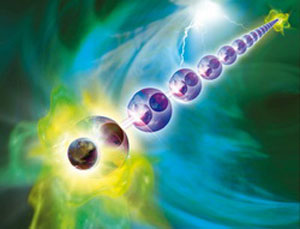| Oct 24, 2011 |
The exotic topological states of matter
|
|
(Nanowerk News) Researchers in Austria have come up with new ideas to engineer exotic, so-called 'topological states of matter' in quantum mechanical many-body systems. Presented in the journal Nature Physics ("Topology by dissipation in atomic quantum wires"), the study was funded in part by the NAME-QUAM ('Nanodesigning of atomic and molecular quantum matter') and AQUTE ('Atomic quantum technologies') projects of the EU. Both projects are supported under the 'Information and communication technologies' (ICT) Theme of the Seventh Framework Programme (FP7) to the tune of EUR 2.09 million and EUR 5.3 million, respectively.
|
 |
| Majorana fermions are then generated at both ends of the atomic chain (© H. Ritsch)
|
|
The University of Innsbruck scientists associated concepts of quantum optics and condensed matter physics, and demonstrated how a quantum computer that is 'immune against perturbations' can be developed.
|
|
Physicists Sebastian Diehl and Peter Zoller presented in 2008 a fresh approach for the engineering of quantum states in many-body systems. They used a physical phenomenon that usually significantly intensifies the degree of disorder in a system, called dissipation. Experts define dissipation as the concept that describes heat production through friction.
|
|
But in quantum physics, dissipation can bring about order. A pure many-body state can also emerge. Led by Rainer Blatt, the Innsbruck group in this latest study showed experimentally that a number of quantum effects can be produced and heightened through dissipation.
|
|
In collaboration with the Institute for Quantum Optics and Quantum Information of the Austrian Academy of Sciences, the Innsbruck researchers provide key insight into how dissipation could be used for other advantages.
|
|
They point out that topological order helps elucidate order in many-body systems in the realm of condensed matter physics. For instance, the quantum Hall effect and the topological insulator are topological phenomena. The former was demonstrated in the 1980s and the latter was found to behave as an electrical insulator in its interior while enabling the transport of charges on its surface.
|
|
The team of Drs Diehl and Zoller propose realising dissipation-induced Majorana fermions in a quantum system. This topological phenomenon was named after the Italian physicist Ettore Majorana and describes particles that are their own anti-particles.
|
|
'We show a new way of how Majorana fermions may be created in a controlled way in a quantum system,' Dr Diehl says. 'For this purpose we use a dissipative dynamic that drives the system into this state in a targeted way and compels it back when affected by disturbances.'
|
|
The scientists say both concepts are highly robust against perturbations such as disorder. 'We work at the interface between those two disciplines, which creates exciting new possibilities,' Dr Diehl says. 'We were able to tick off all points on the topological checklist and show that its prerequisites are also valid in a system with dissipative dynamics.'
|

